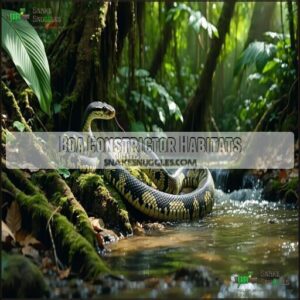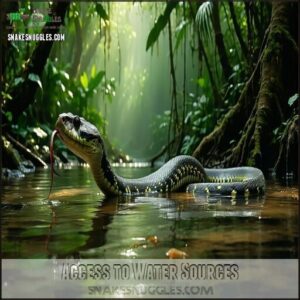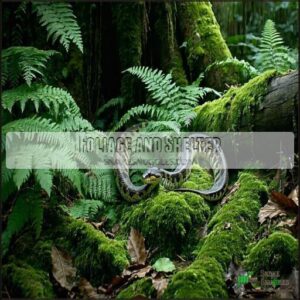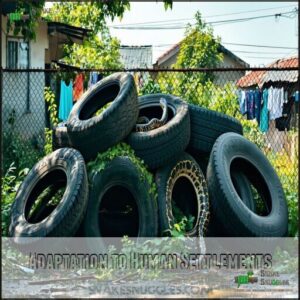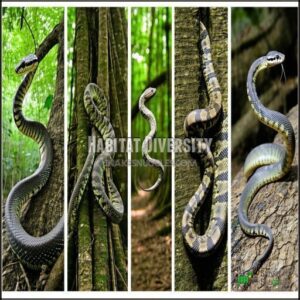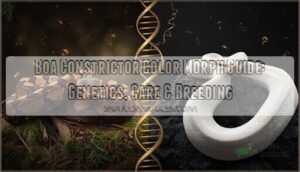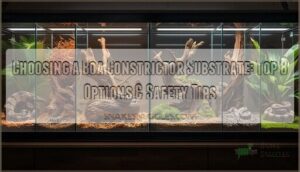This site is supported by our readers. We may earn a commission, at no cost to you, if you purchase through links.
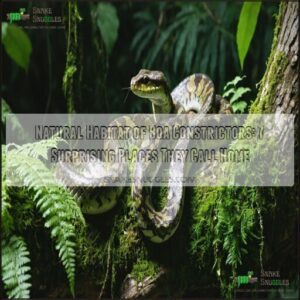 You’ll find boa constrictors making themselves at home in diverse settings across Central and South America.
You’ll find boa constrictors making themselves at home in diverse settings across Central and South America.
The natural habitat of boa constrictors ranges from tropical rainforests and humid swamps to dry savannas and even semi-arid regions.
These adaptable reptiles don’t stick to just one neighborhood—they’re equally comfortable slithering along forest floors, climbing trees, or lounging near water sources.
They prefer warm climates where they can regulate their body temperature, and they’re masters at blending into their surroundings.
While they might seem intimidating, these snakes are actually quite selective about where they settle down, choosing locations that offer both protection and prime hunting opportunities.
They are highly adaptable and can be found in various environments, from forest floors to trees.
Boa constrictors are skilled hunters and need locations that provide them with the necessary conditions to thrive.
Table Of Contents
- Key Takeaways
- Boa Constrictor Habitats
- Geographic Distribution
- Environmental Requirements
- Adaptation to Human Settlements
- Habitat Diversity
- Frequently Asked Questions (FAQs)
- What is the best habitat for a boa constrictor?
- Where are boa constrictors commonly found?
- Where do boa pythons live?
- What climate do boa constrictors live in?
- How do boa constrictors interact with other wildlife?
- Do boas hibernate in colder regions?
- How do wildfires affect boa habitats?
- What conservation efforts protect wild boas?
- How does climate change impact boa populations?
- Conclusion
Key Takeaways
- You’ll find boa constrictors thriving across diverse environments from tropical rainforests to surprisingly arid regions, always preferring locations with access to water sources and ample hiding spots.
- Boa constrictors have adapted remarkably well to human-modified landscapes including agricultural fields and urban areas, where they often provide valuable rodent control despite facing habitat loss.
- You’ll encounter these snakes throughout a vast geographic range spanning from Mexico through Central America and deep into South America, with populations even established on Caribbean islands.
- Boa constrictors require warm environments (75-85°F) with moderate humidity (60-80%), adequate shelter in vegetation or rock crevices, and reliable water sources to regulate their body temperature and support hunting activities.
Boa Constrictor Habitats
You’ll find boa constrictors thriving across diverse environments from the lush canopies of tropical rainforests to surprisingly arid regions, always preferring locations with access to water sources and ample hiding spots.
Adaptable and resourceful, boa constrictors thrive wherever water flows and shadows offer sanctuary.
These adaptable reptiles have made themselves at home throughout Central and South America, occupying everything from dense jungle floors to the edges of human settlements where prey is abundant.
Tropical Rainforests
Thriving in the lush canopy coverage of tropical rainforests, boa constrictors find their ultimate paradise.
You’ll spot these magnificent snakes gliding across the forest floor where humidity levels remain consistently high.
They’re perfectly adapted to this rainforest snake habitat, using fallen logs and dense vegetation for shelter.
The tropical environment offers abundant prey and protection from predators.
Conservation efforts focus on preserving these essential boa constrictor habitats against increasing deforestation threats to ensure the survival of these magnificent creatures in their natural tropical environment.
Savannas and Grasslands
Unlike dense rainforests, savannas and grasslands offer boa constrictors a different hunting ground. These open habitats provide unique challenges and opportunities for these adaptable reptiles.
Boa constrictors thrive where they can find adequate shelter.
- Grassland prey includes rodents, ground-nesting birds, and small mammals
- Boa camouflage works differently here, relying on tall grasses for concealment
- Seasonal changes force boas to adjust hunting strategies throughout the year
- Open habitat requires more nocturnal activity to avoid predators
- Savanna ecosystems offer abundant prey during migration seasons
Desert Regions
While grasslands offer open terrain, boa constrictors also make their home in surprising desert environments.
You’ll find these remarkable snakes in arid regions like the Sonoran Desert across northwestern Mexico.
Despite limited resources, boas excel at desert survival through impressive habitat adaptations. They’ve developed sophisticated thermoregulation skills and water conservation techniques that help them thrive when temperatures soar.
| Desert Habitat | Boa Adaptations | Survival Strategy |
|---|---|---|
| Sonoran Desert | Heat sensing pits | Locates water sources |
| Coastal thornscrub | Body temperature control | Hunts during cooler hours |
| Tropical deciduous forests | Underground retreats | Conserves moisture |
| Canyon systems | Specialized scales | Reduces water loss |
| Arid Mexico regions | Efficient hunting | Maximizes desert prey capture |
Riparian Areas
While desert boas conserve moisture, their relatives near water live quite differently.
You’ll find boa constrictors thriving along riverbanks, streams, and lakes where riparian hunting opportunities abound.
These water-loving snakes use their excellent aquatic skills to navigate waterways, finding both prey and hydration sources in one location.
Riverbank shelter provides perfect ambush spots, where they’ll wait patiently for unsuspecting animals coming to drink.
Water proximity is a key habitat requirement for many boa populations, and they take full advantage of their excellent aquatic skills and perfect ambush spots to thrive in their environment.
Arboreal Environments
Look up into the dense vegetation of tropical rainforests, and you’ll spot young boa constrictors making their way through the canopy with impressive climbing techniques.
Look skyward in tropical forests and witness nature’s acrobats—young boas navigating the canopy with graceful precision.
These arboreal habitats serve as ideal juvenile habitat, where smaller boas develop their climbing skills while hunting birds and small mammals.
The rainforest ecosystems provide perfect arboreal adaptation opportunities, allowing them to perfect their canopy hunting strategies before eventually descending to more terrestrial lifestyles as they grow larger, utilizing their learned skills for terrestrial lifestyles.
Geographic Distribution
Nearly every corner of the Americas hosts boa constrictors, with their distribution spanning from Mexico through Central America and deep into South America.
You’ll find these impressive snakes across a vast latitudinal range that extends along both sides of the Andes Distribution boundary. Their presence isn’t limited to mainlands, as they’ve established thriving island populations throughout the Caribbean islands, including Trinidad and Tobago.
Boa constrictor range includes:
- Tropical lowlands of Mexico and Central America
- Amazon Basin and northern Argentina in South America
- Caribbean islands like St. Lucia and the Lesser Antilles
- Introduced species populations in southern Florida and U.S. Virgin Islands
Habitat fragmentation threatens many native populations, particularly where urban development intersects with their natural territories. The boa constrictor’s range is impacted by climate and habitat. As the saying goes, "where there’s tropical warmth and prey, the boa will find a way.
Environmental Requirements
You’ll find that boa constrictors thrive in warm, humid environments with access to both water sources and adequate foliage for shelter.
Their remarkable adaptability allows them to establish homes across varied terrains and elevations, from tropical rainforests to semi-arid regions, as long as their basic temperature and humidity requirements are met, which is a key factor in their ability to survive in warm environments.
Warm and Humid Climates
Beyond their wide geographic distribution, boa constrictors thrive specifically in tropical and subtropical environments where warmth and humidity create their ideal conditions.
You’ll find these remarkable reptiles most comfortable when temperatures range between 75-85°F with humidity levels of 60-80%.
Their bodies are perfectly adapted to these steamy conditions, which mirror their native tropical rainforests throughout Central and South America.
Climate change threatens these delicate microclimates, potentially altering seasonal variations that boas rely on.
Access to Water Sources
While boas thrive in warm climates, they’re never far from water.
You’ll find these remarkable reptiles strategically positioned near rivers, streams, and lakes that serve as hydration centers and hunting grounds.
Their aquatic skills make riparian hunting particularly effective.
In drier regions, boas have developed impressive water conservation techniques, using isolated water sources not just for drinking but as thermoregulation aids during extreme temperatures.
Their distribution largely follows water availability across their range, making them well-adapted to their environments with effective hunting strategies.
Foliage and Shelter
Nature provides these impressive reptiles with essential shelter options across their range.
You’ll find boa constrictors relying on specific foliage and shelter characteristics for survival:
- Canopy density offers protection from predators and harsh weather conditions
- Ground cover provides perfect hiding spots for ambush hunting
- Fallen logs and rock crevices create secure resting areas
- Dense vegetation supplies critical thermal cover during temperature extremes
- Habitat complexity increases hunting success and reduces detection
Boa constrictors thrive amongst lush terrarium foliage in areas with specific foliage and harsh weather conditions, where they can utilize dense vegetation for survival.
Elevation and Terrain
You’ll find boa constrictors thriving across a remarkable range of elevations and terrains.
These adaptable reptiles make their homes from sea level coastal areas to heights of several thousand feet in the Andes Mountains.
Their geographic distribution spans gentle slopes, rocky outcroppings, and varying terrain types, while they prefer moderate altitudes.
Some mountain adaptations allow certain subspecies to survive in more extreme habitat variations, showing impressive altitude limits despite their tropical origins.
Some snake species, like the mountain gartersnake’s habitat, reach elevations of over 11,000 feet, demonstrating remarkable adaptability and ability to thrive in varied environments.
Adaptation to Human Settlements
You’ll be surprised to find that boa constrictors have become remarkably adaptable to human-modified landscapes, including agricultural fields and even urban areas near water sources.
These resourceful reptiles often utilize man-made structures for shelter while taking advantage of the abundant rodent populations that typically accompany human settlements, and are remarkably adaptable.
Agricultural Areas
You’ll often find boa constrictors adapting surprisingly well to agricultural areas, where they provide valuable rodent control despite facing habitat loss.
These resilient reptiles navigate human-modified landscapes with remarkable flexibility.
- They hunt crop-damaging rodents, naturally controlling pest populations
- Farmers sometimes welcome boas as free pest management
- They face dangers from pesticide exposure in farmlands
- Livestock interaction can lead to human-snake conflicts
- Conservation efforts focus on teaching farmers their ecological value. Some farmers utilize specialized boa products for assistance.
The presence of boa constrictors in agricultural areas highlights the importance of conservation efforts and understanding the human-snake conflicts that can arise from their interaction with livestock and pesticide exposure.
Urban Environments
Surprisingly, boa constrictors have adapted to urban environments where they hunt rats and other pests.
You might spot these resourceful reptiles in cities like Guayaquil, Ecuador, or Mayagüez, Puerto Rico, where they’ve established breeding populations.
They’re drawn to human settlements for warmth and shelter, often seeking refuge in vehicles or buildings.
Those interested may wish to purchase urban boa constrictor themed items.
While urban adaptation demonstrates their resilience, it also creates human-boa conflicts that wildlife biologists address through careful relocation programs.
Introduced Habitats
While cities offer boa constrictors new hiding spots, you’ll find these remarkable reptiles thriving in locations where they don’t naturally belong.
Several regions now host introduced boa constrictor habitats, primarily due to pet trade releases by overwhelmed owners.
Florida populations have flourished since the 1970s in Miami-Dade County, while other introduced habitats include:
- Aruba (discovered 1999, widespread by 2005)
- Cozumel Island, Mexico (introduced 1971)
- Puerto Rico (breeding population from 1990s pet releases)
- Southern Florida (established in tropical hammocks and pine rocklands)
Impact on Local Ecosystems
When boa constrictors enter new areas, they’re not just passing through—they’re changing the neighborhood.
You’ll notice these powerful hunters can dramatically alter prey populations in introduced habitats.
They compete with native predators for food and shelter, potentially disrupting the ecosystem balance.
In Florida, they’ve joined other invasive species in reshaping ecological roles and predator-prey relationships. Conservation efforts now focus on maintaining ecosystem health by managing these unexpected residents.
Habitat Diversity
You’ll find boa constrictors thriving across an astonishing range of environments, from the dense canopies of Central American rainforests to the arid scrublands of South America.
Their remarkable adaptability allows them to establish populations in diverse habitats including Caribbean islands, tropical forests, savannas, semi-deserts, and riparian zones where they’ve perfected survival strategies unique to each ecosystem, showcasing their ability to thrive in various conditions with remarkable adaptability.
Central American Ranges
Across Central American ranges, you’ll find Imperial boa constrictors thriving in diverse habitats from rainforest edges to dry tropical forests.
These adaptable Central American snakes face increasing habitat fragmentation due to human encroachment. You can spot them in woodlands, grasslands, and near streams where prey availability remains high.
Despite climate impact concerns, conservation efforts focus on preserving these critical corridors connecting boa constrictor habitats, ensuring their survival against the rising tide of development.
They play a pivotal role in jungle trophic relationships.
South American Countries
South America houses at least nine countries where boa constrictors thrive in astonishingly diverse ecosystems.
You’ll find Amazonian Boa Range extending through Brazil’s lush rainforests, while Andean Boa Habitats occupy the mountainous regions of Colombia and Ecuador.
From Venezuela’s coastal areas to the Southern Cone Boas in Argentina’s drier landscapes, these adaptable serpents have conquered varied terrains.
Though facing habitat loss, significant Boa Conservation Efforts protect their natural habitat across the continent, which is crucial for the boa constrictors.
Caribbean Islands
The Caribbean islands host fascinating endemic subspecies of boa constrictors. You’ll find these remarkable snakes thriving in tropical habitats across several islands, where island boa evolution has created distinct populations.
Four notable Caribbean boa constrictor habitats include:
- Trinidad and Tobago, home to the locally-named "macajuel" boa
- St. Lucia with its endemic B. c. orophias subspecies
- Dominica’s lush tropical snake habitat
- Lesser Antilles, where conservation efforts combat habitat fragmentation
Unique Subspecies Habitats
While island boa populations showcase remarkable adaptations to their isolated homes, each boa constrictor subspecies has evolved unique habitat preferences.
You’ll find montane subspecies thriving in elevated terrain, while coastal boa niches feature specialized hunting behaviors.
Desert boa adaptation includes remarkable water conservation skills. Some subspecies occupy extremely limited ranges, like the Pearl Island Boa which inhabits just one specific island ecosystem.
Introduced subspecies have established populations in southern Florida, demonstrating their impressive adaptability across habitat variations.
Frequently Asked Questions (FAQs)
What is the best habitat for a boa constrictor?
You’ll find boa constrictors thrive best in tropical rainforests near water sources where they can access both arboreal and terrestrial hunting grounds.
They’re quite adaptable though, making do in savannas and semi-arid regions too.
Where are boa constrictors commonly found?
In a world of their own, boa constrictors call tropical regions of Central and South America home.
You’ll find them in rainforests, savannas, woodlands, and near water sources across Mexico, Brazil, and Caribbean islands.
Where do boa pythons live?
Boa constrictors thrive in tropical regions across Central and South America, from Mexico to Argentina. You’ll find these remarkable reptiles in rainforests, savannas, and semi-arid zones, typically near water sources.
What climate do boa constrictors live in?
In the lap of luxury, you’ll find boa constrictors thriving in tropical and subtropical climates.
They prefer warm, humid environments with temperatures between 75-95°F, though they’ve adapted to diverse habitats from rainforests to semi-deserts, including tropical areas.
How do boa constrictors interact with other wildlife?
As apex predators, you’ll find boa constrictors hunting small mammals and birds while avoiding larger predators like jaguars and eagles.
They’re occasionally prey themselves but mostly maintain a balanced role in their ecosystem’s food chain.
Do boas hibernate in colder regions?
Instead of hibernating, you’ll find that boa constrictors enter brumation when temperatures drop.
They’ll become less active and eat less, but won’t fall into the deep sleep that true hibernation brings.
How do wildfires affect boa habitats?
Wildfires destroy your boa’s cover and prey sources, forcing them to relocate.
You’ll find they’re particularly vulnerable when logs and vegetation are removed, eliminating essential shelter and disrupting their natural hunting grounds.
What conservation efforts protect wild boas?
You’ll find boas protected through CITES Appendix II regulations, which control international trade.
Conservation organizations also work on habitat restoration programs, while some countries host "Exotic Pet Amnesty Days" where you can surrender unwanted pet boas without consequences, which is an Exotic Pet amnesty initiative.
How does climate change impact boa populations?
Climate change threatens up to 90% of boa habitats with shifting temperature patterns.
You’ll notice boas struggling as altered breeding cycles, reduced prey availability, and increased wildfires disrupt their ecosystems, making them more vulnerable to extinction.
Conclusion
Like a living tapestry woven through the Americas, the natural habitat of boa constrictors showcases their remarkable adaptability.
You’ll find these resilient reptiles thriving from rainforest canopies to desert fringes, always seeking the perfect balance of warmth, shelter, and hunting opportunities.
Whether you’re exploring Central American jungles or South American savannas, remember that these impressive snakes have mastered survival in diverse ecosystems.
Their ability to adapt makes the natural habitat of boa constrictors a fascinating study in evolutionary success.
- https://www.knobcreeknaturalist.com/blog/substrate-options-for-boa-constrictor
- http://www.funappschool.com/AnimalAdaptations/BoaConstrictor
- https://animals.howstuffworks.com/snakes/boa-constrictor.htm
- https://commons.wikimedia.org/wiki/File:Boa_constrictor,_Va%C5%88kovka,_Brno_(2).jpg
- https://creativecommons.org/licenses/by-sa/4.0

